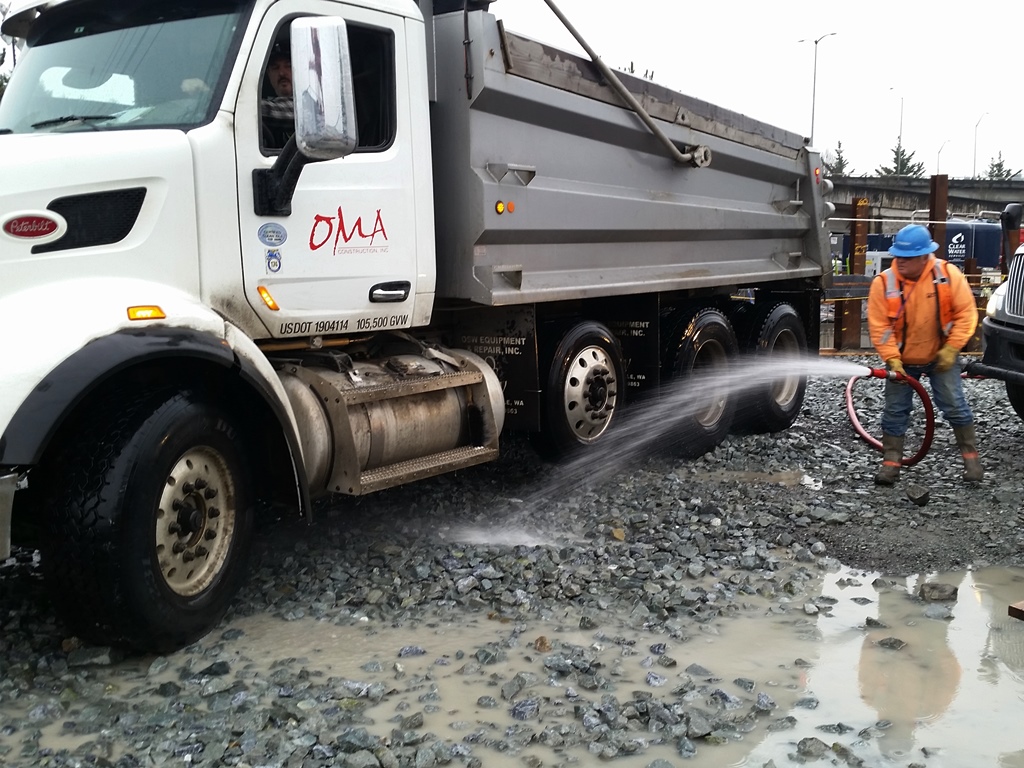This is a blast from the past. I think I wrote this in 1996 with I was the first State-wide Erosion Control Coordinator at the Washington State Dept. of Transportation.
Preventing erosion is the best preparation. Here are some things to consider when you prepare for fall and winter rains:
Cover bare soil. Final grades can be covered with hydroseed, erosion blankets, topsoil, bark or whatever final cover is planned for the project.
Get your hydroseed contractor lined up now and avoid the October rush.
Don’t open up more than a few acres after September 1st.
Grades that aren’t being actively worked can be covered with straw at a rate of 3000 pounds per acre. This is a very cheap and effective way to protect bare soil from raindrop impacts and erosion. Hand seed before spreading the straw. Spray it with water to help hold it in place.
Track your slopes with a Cat: up and down slope, not across slope. The first helps prevent erosion, the second speeds it up.
Use flex pipe drains at bridge ends if your permanent drainage system and curbs are not in place. Collect the water from the bridge using sand bags and divert it to the pipe. Make sure the pipe is long enough to reach the bottom of the slope.
Another good way to prepare for fall and winter rains is to use a water truck and water seeded areas weekly to get quicker growth. The better the growth going into winter the better.
If you have to open up a large area, only clear and grub small areas. You can clear larger areas if you don’t grub. Roots and slash help protect the bare soil.
Walk the site looking only at erosion controls, thinking ahead of areas that could have a problem. Identify them and start making additions and corrections.
Locate all existing water flows in and around your project and find out where they drain to.
Think about maintenance and regular inspection of erosion controls. When are silt fences going to be inspected and who does it? Who removes mud from check dams? Who covers slopes with straw or other mulch?
Get materials on site now. Again beat the rush for materials in October and November when everyone is in a panic to get plastic and straw. Stockpile enough straw, plastic, silt fence, flex pipe, sand bags, seed, rock, now to cover all areas that are bare.
Set up emergency procedures now. Who should be called in emergencies? Do you have a Certified Erosion and Sediment Control Lead (CESCL)? Brief your personnel on what to do if they see muddy water and who to go to.
Make sure that erosion control material installers know proper installation methods.
Make sure all your silt fence is installed on contour with the ends flared up slope a few feet. If it is not on contour, identify the lowest points of the fence as these will be the failure spots. Install a double row of silt fence at these low spots before you have a failure. Double up your silt fence in areas where eroding slopes could flow into wetlands or streams.
Do you have bare spots where previous seeding hasn’t grown? Cover it with seed and straw if the area is small, remobilize the hydroseeder for larger areas.
Make sure all catch basins within the project boundary are protected with inserts, fence surrounds, or other methods to keep mud out. Locate any catchbasins outside project boundaries that may receive water from your site and protect them.
Make sure that you have a copy of the Temporary Erosion and Sediment Control plan (TESC) and any grading or environmental permits on site in the job shack. Know what they say. Give each inspector a copy of the TESC to keep in their truck. These are working copies that can be adapted to site conditions.
Modify your permanent stormwater ponds into temporary sediment ponds by installing a standpipe and blocking the outlet with sand bags. Cut a few small holes in the standpipe to allow for slow release of water. You can also use perforated pipe as the standpipe and hold it in place with “T” posts, wire, and gravel piled up around it.
Use geotextile fabric as a temporary ditch lining to protect bare soil from erosion. Hold the fabric in place with rock check dams, wooden stakes, or sand bags.
Make sure that all check dams are installed so that the top center point is lower than the bottom end points. This prevents end-cutting. You may have to add more material to the dam to increase the width, especially on wide ditches with shallow grade side slopes.
Now you know how to prepare for fall and winter rains: Prevent Erosion



